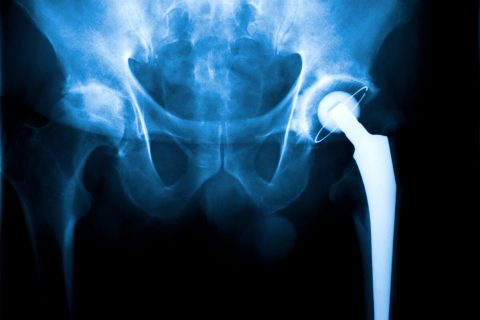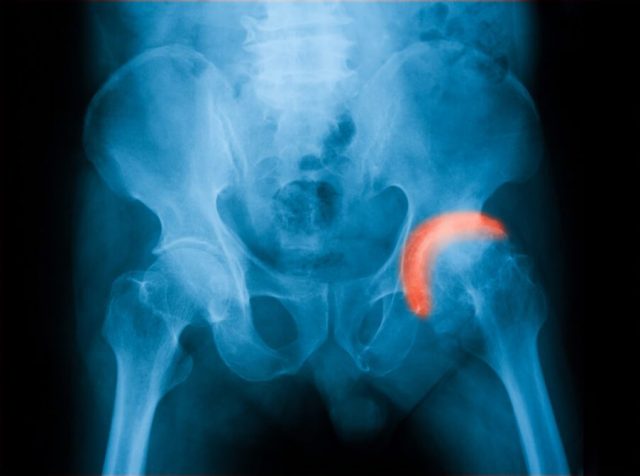
Hip Revision Surgery
When a hip replacement wears out or fails prematurely, patients require revision surgery to treat complications and receive new implants. Revision surgery can be riskier than the original hip replacement, but the procedures can relieve pain and restore mobility.
Revision surgery takes more time in the operating room than a patient’s original hip surgery takes. It is also more complex. Because of those conditions, revision surgery also has a greater risk of complications, such as infection, implant failure and nerve damage, making careful planning and skilled surgical intervention crucial.
A 2022 study reported that, following a hip replacement, 46.7% of participants experienced a clinically significant improvement, while 15.5% experienced worsened outcomes. These findings highlight the potential for both positive and negative results, underscoring the importance of patient selection and post-surgical care to maximize outcomes.
The vast majority of hip replacement surgeries are successful. But 4 to 5 percent of people who receive a hip implant may require revision surgery within 10 years, according to a 2017 study in The Lancet. The same study found that 15 percent of patients needed revision surgery within 20 years.

The American Academy of Orthopaedic Surgeons estimates that by 2030, surgeons in the United States will perform 635,000 total hip replacements and 72,000 hip revision surgeries a year. This trend reflects the aging population and the increasing demand for hip replacement procedures, as well as the need for subsequent revision surgeries. The possibility of revision surgery is something to keep in mind if you are considering having or have already undergone a hip replacement.

Dr. H. John Cooper, an orthopedic surgeon with Columbia Doctors in New York, estimates that he performs one revision surgery a week — about 400 in the last 8 years.
“The risk of having a problem with the joint replacement is not the same for everybody,” Dr. Cooper told Drugwatch. “It is very different person to person, and it depends a lot on individual patient factors, most of them related to the patient’s health.”
Patients can sometimes reduce the risk of complications that lead to revision surgery. Antibiotics can catch infections before they spread. Patients can also avoid dislocation by following the post-surgical care and safety instructions. Avoiding high-impact activities and following specific movement precautions can help prevent dislocations and other complications.
However, infections, trauma, natural wear and defective implants can make revision surgery unavoidable.
Metal-on-Metal Implants Have Higher Rates of Revision Surgery
Metal-on-metal hip implants had a higher than expected failure rate. Companies faced thousands of lawsuits over the devices and had gradually pulled them off the market by the mid-2010s. These implants led to complications like metallosis, increased wear, and premature implant failure, prompting tighter FDA regulations. No metal-on-metal total hip replacements are currently approved for use in the United States. But thousands of people may still be walking around with one or even two.
The FDA has approved two metal-on-metal hip resurfacing devices since requiring makers to prove safety and effectiveness before selling implants.
The term metal-on-metal applies generally to devices that featured a metal ball fitted atop the thighbone that fit into a metal socket or liner implanted into the hip. When people walked, the metal parts would rub against one another, releasing ions that could cause complications.
- DePuy’s ASR
- Johnson & Johnson’s DePuy ASR had a 40 percent failure rate within the first 5 years, according to internal company information revealed during a lawsuit. This alarming failure rate led to the recall of the device and legal settlements for affected patients.
- Zimmer’s Durom Cup
- About 16 percent of patients who’d received a Zimmer Durom Cup required revision surgery for loosening within two years of receiving it, according to a 2009 study.
- Biomet’s M2a Magnum
- The Biomet M2a Magnum was the most common hip replacement implanted by doctors at Turku University’s hospital in Finland from 2005 to 2012. A 2018 hip lawsuit filed in a Missouri federal court claimed that the university had reported “adverse reaction to metal debris” in more than half of 74 patients implanted with the device.
- Stryker’s Rejuvenate
- A follow-up study of 92 patients who’d received a recalled Stryker Rejuvenate hip with modular stem found that 13 percent of patients had developed complications within 2 years. Two-thirds of them required revision surgery. While the Rejuvenate did not feature a metal ball fitted into a metal socket, the movement between its metal neck and the connecting metal stem was believed to release ions that caused serious complications in some patients.
Reasons for Revision
People require hip replacement revision surgery because either their hip implant wears out or they experience complications. These complications often result in severe pain, loss of mobility and a decreased quality of life.
“Device related problems seem to be responsible for less than 5 percent of the reason that we do revisions,” Dr. Cooper told Drugwatch. “More common things — just to put that into perspective — are things like infection, which is responsible for 30 or 40 percent of the revisions that we need to do.”
Signs that a person needs a revision surgery include pain that comes on suddenly, swelling or trouble moving the joint.
- Allergy to metal in the implant
- Fracture of bones around the implant
- Implant wear and loosening
- Infection
- Reaction to metal ions
- Recurring dislocation
Source: American Academy of Orthopaedic Surgeons
Anyone who experiences these conditions should see a doctor immediately.
Doctors will perform tests to determine whether revision surgery is necessary. Tests for implant failure are more intensive than tests for natural hip failure.
- X-rays
- CT scans
- MRIs
- Blood tests
- Synovial (joint) fluid analysis
People who receive a hip replacement at a young age or people who live active lifestyles may require at least one new hip replacement in their lifetimes simply because they’ll live long enough to wear out the implant.
- High impact exercise
- Playing sports
- High weight
- Type of implant
- Disease such as osteoporosis
Some implants fail for reasons other than normal wear. Complications that cause revision surgery include infection, defective hip implant design and poor surgical technique. Each of these can cause severe pain, recurring dislocation or implant failure (fracture or loosening).
The hip can become infected in the initial weeks after surgery or even much later if a person has an infection in a different part of the body. Dislocation happens when the ball slips out of the socket portion of the hip implant. This can be caused by extraneous exercise, trauma, a faulty implant or normal wear.
Types of Surgery
The type of revision surgery depends on the cause of the revision, the type of hip replacement components the person received and the individual patient. Surgeons tailor the procedure to address complications like dislocation, infection, or implant failure.
If a patient is experiencing recurring dislocations, the surgeon may realign components or insert new components to prevent dislocations. To aid implant stabilization, patients may need to wear a brace for several weeks, depending on the severity of their condition and the surgeon’s recommendations.
- Surgical cleaning
- If the infection is recognized quickly, the joint implant is cleaned and the original implant is left in the patient. The patient will usually take antibiotics for several weeks or months.
- One-stage hip replacement
- The surgeon will remove the implant, clean the bone, and implant a new hip replacement. The patient usually takes antibiotics for several weeks or months.
- Two-stage hip replacement
- The surgeon will remove the implant, clean the bone, implant a spacer, and implant a new artificial hip. Then the patient will take antibiotics for six weeks.
Mechanical failure usually occurs when a patient’s bone or tissue is weakened by particles that are released from the implant. The damaged tissue allows the implant to become loose. This can cause a bone fracture or implant fracture.
To fix mechanical failure, the surgeon will remove the implant and assess bone and tissue damage. They may use a bone graft (bone transplant), custom-made 3D-printed metal augments or other surgical techniques to repair the hip. Then they’ll implant new hip replacement components.
What to Expect in Revision Surgery
Revision surgery takes several hours in most cases. The surgeon makes an incision and then removes, replaces or reconstructs the hip replacement. Recovery time is generally similar to that following the original surgery.
- Re-incision
- The surgeon usually makes an incision along the original surgery incision. It may be longer to allow the removal of the old implant. The doctor will examine surrounding tissue for signs of infection or damage from particles the implant may have shed.
- Removal & Reconstruction
- The surgeon carefully removes the old implant and any cement, preserving as much bone as possible. Reconstruction of any defects may involve stabilization of the joint with bone graft or metal augments if needed. The doctor may have to cause a “controlled fracture” of the thighbone if he has to remove the stem. This will be repaired once the new stem is inserted. Then the surgeon will insert new hip replacement components and test the motion of the new artificial hip.
- Recovery
- The patient is taken to a recovery room and monitored for several hours while recovering from anesthesia. The recovery process is similar to that following the original replacement surgery. The surgeon will provide any special instructions for individual patients.
"Ideally, we’re looking to get patients back to work after a joint replacement within a matter of weeks to a couple of months," Dr. Cooper said.
But he adds that in some extreme cases, due to complications or a patient's health, that time can be doubled, tripled or even take a couple of years.
Revision Complications
Because more bone is removed in a revision surgery, some complications may be more pronounced than those following the original operation. Some people may also require more than one revision surgery.
People should follow their doctors’ instructions to avoid possible complications. They should also talk to their doctor immediately if they suspect complications.
- Blood clots
- Blood vessel damage
- Different leg lengths
- Dislocation
- Failure for bone to attach to the implant
- Fractures
- Heterotopic ossification (new bone growth where it shouldn’t be)
- Infection
- Loosening
- Nerve damage
- Pulmonary embolism (a blood clot that travels to the lung)
Source: American Academy of Orthopaedic Surgeons
Complications can also be caused by anesthesia used during surgery. Patients should talk to their doctor about what anesthesia will be used and what the risks are in the weeks or days before surgery.
Risk of Death
Hip replacement surgery is one of the most successful procedures performed in the United States. Revision surgeries carry the risk of more complications, but the risk of death remains low.
A 2010 study in the journal Orthopedics looked at 1,737 hip and knee revision patients. The overall mortality rate within three months of revision surgery was 0.7 percent. Patients younger than 70 had a much lower chance of dying. Those older than 80 had a higher rate, although the rate for this age group was only 2.63 percent.
A 2003 study in the Journal of Bone and Joint Surgery – American Volume found similar results. Researchers found the mortality rate for hip revision surgery was 1 percent within three months of revision surgery. But the researchers looked only at Medicare patients who would have been 65 or older.
How Patients Can Prevent Complications
Recovery from revision surgery is similar to recovering from primary surgery. Adhering to recovery precautions similar to those for primary surgery can significantly reduce the risk of complications following revision procedures. Dislocation, leg length differences, infection and blood clots are some of the most common immediately following hip replacement surgeries.
Blood clots are a common risk after any major surgery, and a doctor may prescribe a blood thinner and recommend compression stockings or mobility exercises to prevent them.
Dislocations may happen from putting too much stress on the new implant before the tissue around it has healed. Dislocation is more likely in certain positions, such as when the leg moves inward and rotates too far or if the patient is overweight or puts stress on the joint through lifting or physical activity. The doctor will provide exercise instructions to strengthen the hip without putting too much stress on the new implant.
Tips to Prevent Complications
- Avoid strenuous or high-impact exercises
- Maintain a healthy weight
- Avoid crossing legs or pulling knees up to the chest for 6 to 8 weeks
- Take antibiotics if prescribed
- See the doctor if sudden pain in addition to surgery pain occurs
- Schedule regular checkups and follow your surgeon’s instructions
It’s also important to stay up to date with hip replacement recalls. If the hip implant that you received was recalled, you can ask your doctor if you should have a revision surgery. In almost all cases, it will be safer not to have revision surgery unless you develop complications. But in some cases, your doctor may want to monitor you through regularly scheduled office visits.
How to Identify Your Implant in Case of a Recall
Knowing basic information about your artificial hip can help you in the event of a hip recall. Whether you’ve had a primary hip replacement or a revision, you should keep records of the manufacturer, the model of hip, any medical device ID information and the serial number of the particular implant you received.
How to Identify Your Hip Implant
- Ask the surgeon’s office or hospital where the surgery was performed
- Check your medical records
- Check your insurance records
- Look at your medical device ID card, if you received one
Calling this number connects you with a Drugwatch.com representative. We will direct you to one of our trusted legal partners for a free case review.
Drugwatch.com's trusted legal partners support the organization's mission to keep people safe from dangerous drugs and medical devices. For more information, visit our partners page.

